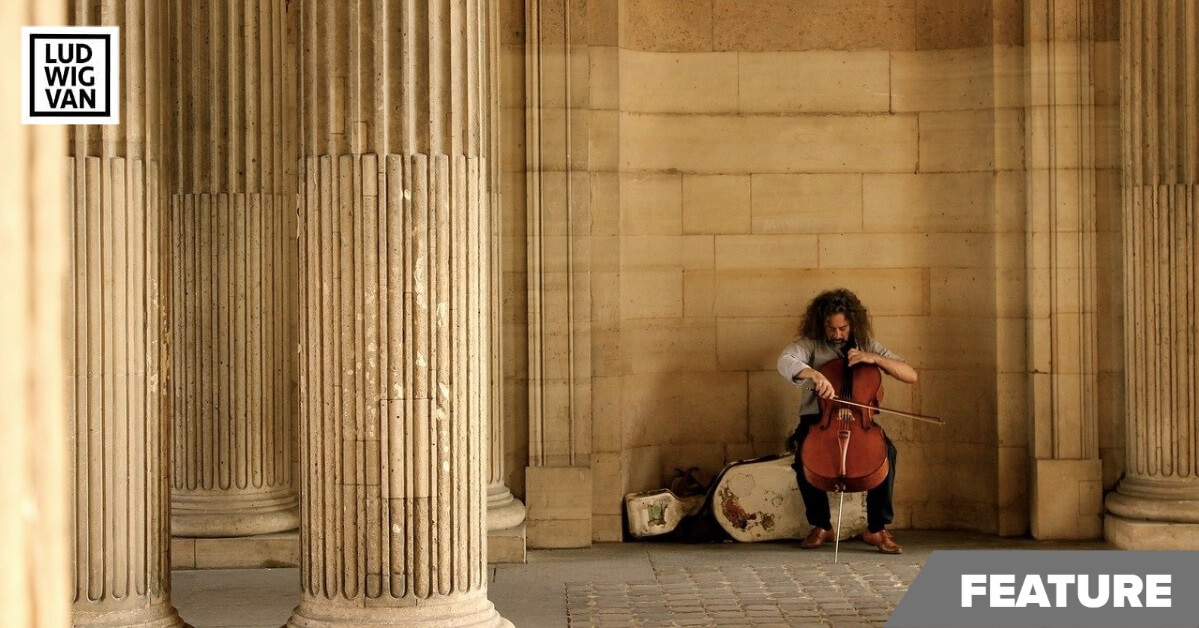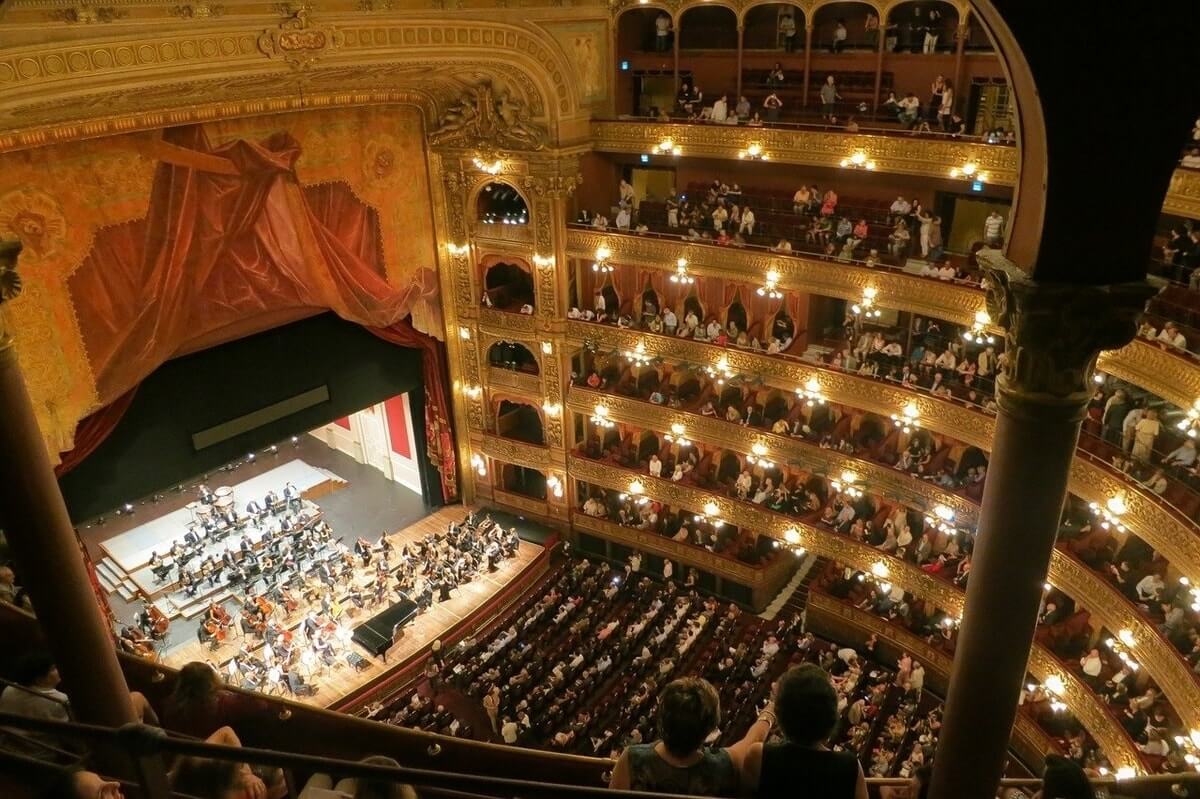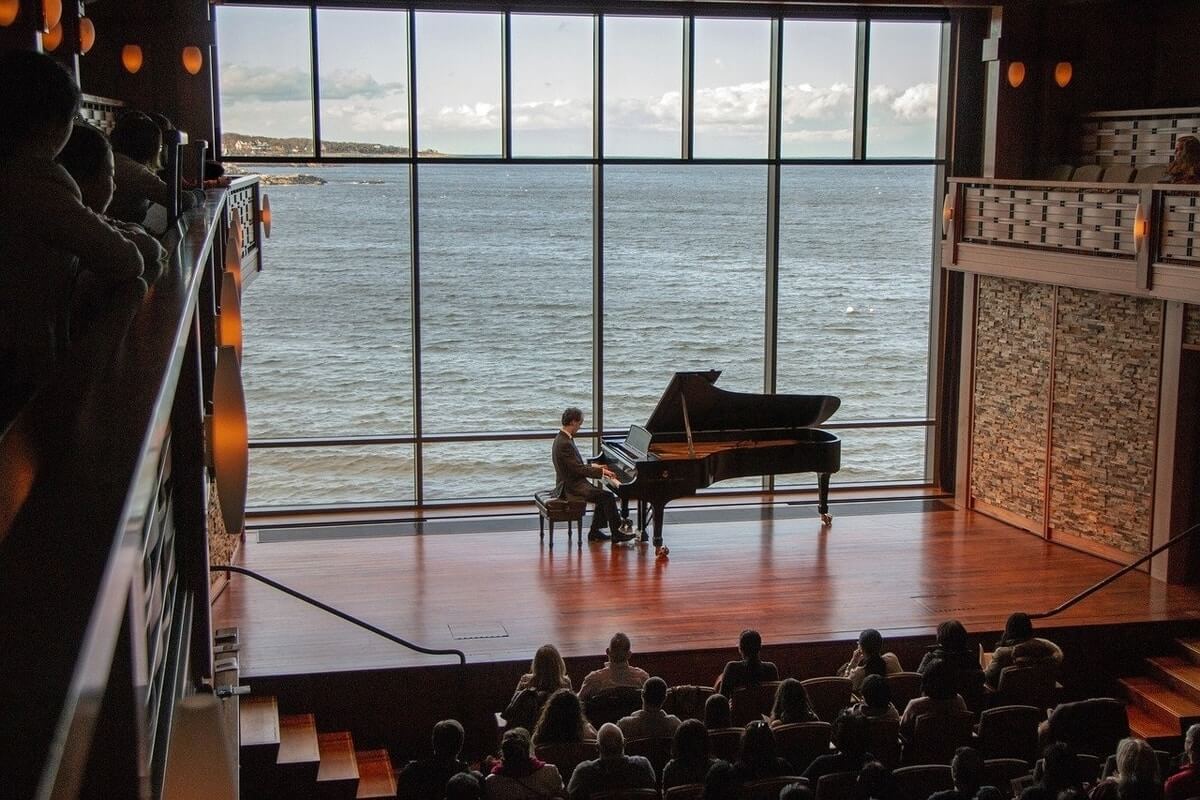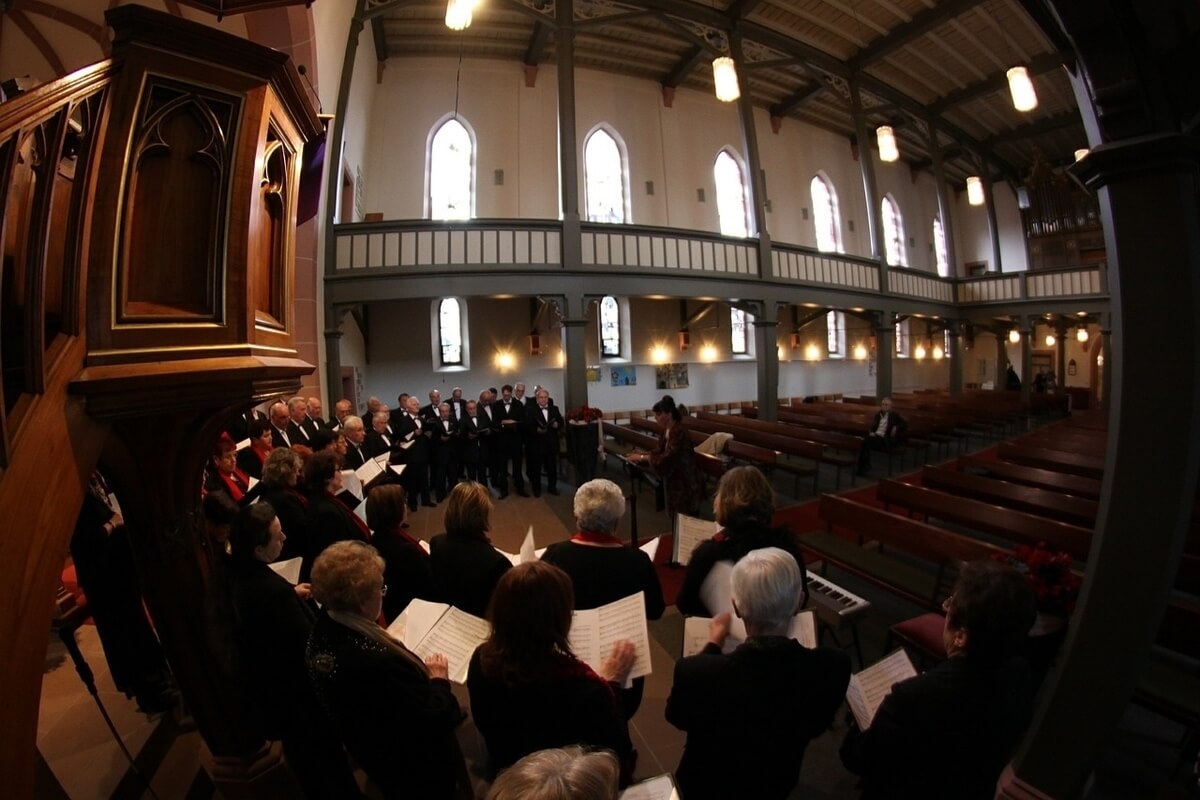We look at how, when, and in what form live music might return after the silent stages of the COVID-19 lockdown.

Since the beginning of the COVID-19 lockdown, classical musicians, orchestras, and other groups have stepped up to the challenge of filling the void with music. While live performances were not possible, established companies with banks of video material like the Metropolitan Opera and Staatsoper Berlin have opened the vaults to free streaming.
Many musicians have made a success in the virtual world. The talented Kanneh-Mason family’s weekly living room livestreams regularly garner upwards of 50,000 viewers. A stream of Bach’s St. John Passion, performed social-distancing style in the St. Thomas Church in Leipzig, Germany, has been viewed about 350,000 times. The performance features a tenor soloist inmost of the vocal roles, with a marimba and keyboard player, and the choruses performed by a virtual choir from around the world. The video of the performance is on view until July 10.
While the online world provides an unexpected boost, and possibility of additional revenues, classical music is a genre that is defined by performance. The concert hall or venue itself adds a different dimension to the experience, along with the undeniable buzz of sharing the performance with others.
It doesn’t help that, in the beginning of the lockdown, estimates were overly optimistic. The first reports talked about getting back to normal in a matter of weeks, then months…now it’s not clear if there will be a performing season per se until 2022.
Even more than the timing is the worry that, in some cases, the season may never really come back at all, and the uncertainty is ongoing.

How Can Audiences Be Coaxed Back?
At Ludwig Van, we created our own survey asking respondents about their attitudes towards the performing arts during the pandemic lockdown. Most of the 619 who responded — a whopping 78.7% — said they had attended a live streamed event, with the majority of people saying they’d seen between one and five virtual concerts. A significant chunk, however, of 25.6% said they’d seen up to 10. Youtube and Facebook were the platforms of choice.
Like reading patterns, however, viewing patterns appear to be different when it comes to live streaming. Just over 30% said they watched the entire performance, with another 31.8% saying they’d checked in for 50-75% of the stream. It leaves, however, just under 38% who stay for less than half of a stream, including 12.6% who stay for less than 5% of the proceedings.
Nonetheless, the results are encouraging, with nearly 40% of our respondents saying they’d pay for a livestream ticket, and another 48.3% who’d consider it. Most people — over 82% — want a true concert from a stage or venue, but there is also solid support for artist chats and mixed chat-concert events, and just under 60% who said they enjoyed an informal stream from the artist’s home.
While the numbers are encouraging, much of the virtual programming has been performed free of charge to viewers, making it an unrealistic long term solution. The bigger question is: what would it take to get audiences back in their seats post-pandemic? A clear majority of 55-62.8 % want social distancing rules to apply, and about the same amount preferred outdoor to indoor venues. Most will also wait well beyond even the removal of government restrictions, however, before going back to a concert or live event.
The numbers and trends of our Ludwig Van survey generally coincide with data gathered across the continent. According to an Abacus Data national opinion survey commissioned by Music Canada, even self confessed music lovers will wait at least six months after the government has lifted restrictions for public gatherings before going to a live concert or venue.
Graham Henderson, President and CEO of Music Canada, is quoted in a media release.
“The music industry faces a triple threat. First – the very real medical concerns of Canadians about the virus. Second — that government restrictions will remain on large gatherings well into recovery. And third — that even after government restrictions have lifted and economies begin to reopen — Canadian confidence in returning to these live events will continue to be low.”
According to data gathered by researchers in the US, where many states have already reopened, most people seem to want to return to cultural life within three months or so. Unfortunately, the same respondents were selective about what they wanted to do. While most would return to activities like visiting public parks and beaches fairly quickly, most also indicated they would not return to pre-COVID-19 levels of attendance at concerts and other live performances, or movie theatres, in the foreseeable future.
The availability of an effective vaccine was the deciding factor for most people who said they wouldn’t go back yet. While several vaccine projects are underway, vaccine and immunology expert Robin Robinson Ph.D. explained to Stat News that it would be some time before it was available to the general public. “I don’t think that the general population will have vaccine probably until the second half of 2021. And that’s if everything works OK,” he said.

The Next Tentative Steps
A fter lockdown, the second phase of pandemic response involves loosening restrictions gradually, always ready to increase testing and possibly go backwards to more restrictive practices based on results.
A state of relative safety will only be reached once there are mass vaccinations and immunity to the virus. Until that time, reopening will be limited, and continue to involve precautions. Digital efforts will be combined with limited live events to help make them more viable.
There is no one-size-fits all solution. How can social distancing work in the performing arts? Theatres and venues around the world are experimenting with possibilities. In Germany, movie theatres have started to reopen. Some have installed plexiglass dividers between sections of seats, while others have removed whole blocks of seats.
neue Realität: so wird es ab nächster Spielzeit im Großen Haus aussehen. #BEsonders2021 pic.twitter.com/ZZuLOHRnLa
— Berliner Ensemble (@blnensemble) May 26, 2020
Seating is only one area of a venue, however.
• How will organizations and venues ensure that social distancing is maintained in lobbies?
• How will seats be assigned?
• Getting into a venue will take much longer. Where will people line up at the box office? Many organizations are already encouraging online-only ticket sales to avoid any contact.
• Another question to be considered is, will organizations screen ticket holders in some fashion to make sure they are not already sick before they enter? Audience data may now also have to include immunity and health check information.
After all the precautions, the larger question remains: how can venues and arts organizations survive on about 20-30% of their audiences? It’s clear that digital initiatives will continue to be crucial during this period to try and help fill in the gaps.
A discussion paper by Toronto’s The Arts Firm Inc. offers some advice to organizations looking to plan for the future. The paper suggests that no one factor will decide audience behaviour. Issues like messaging and awareness of hygiene procedures that have been put into place will become as important as following those procedures.
Because of the ongoing uncertainty and state of flux, organizations will have to operate with shorter and flexible time frames wherever possible.

What About The Performer’s Side Of The Equation?
For woodwind and brass instrumentalists, and singers, in particular, rehearsing and performing as an ensemble is likely to be significantly delayed.
In the US, the National Association of Teachers of Singing got together with the American Choral Directors Association (ACDA), Chorus America, Barbershop Harmony Society, and Performing Arts Medical Association (PAMA) to present a webinar in early May. They were joined by Dr. Donald Milton, Professor of Environmental Health at the University of Maryland School of Public Health, with a secondary appointment in the School of Medicine, and an expert in respiratory epidemiology. Also contributing was otolaryngologist Dr. Lucinda Halstead, founder and medical director of the Evelyn Trammell Institute for Voice and Swallowing at the Medical University of South Carolina, and President Elect of the Performing Arts Medical Association (PAMA).
The live webinar shocked participants with Dr. Halstead’s conclusion that that was no way for singers to rehearse or perform together safely without a vaccine, as well as an effective treatment for the coronavirus. Halstead put that possibility at 18 to 24 months into the future.
Both experts pointed out that there were specific issues that made choirs and singing groups particularly vulnerable. There is no viable distancing solution that would eliminate risk while allowing people to sing together, whether on a stage or a rehearsal hall.
“You would need a football stadium to space apart the Westminster choir,” Halstead noted.
Masks don’t work nearly as well when singing, because of the nature of the activity. She cited the availability of home testing kits as a key requirement. Singers could test themselves before going to each practice.
It means that, going into reopening any kind of performance schedule prior to a vaccine, any ensemble will likely be limited to soloists, duos, or very small groups that can feasibly distance themselves from each other.

Reopening — An Ongoing Experiment
Some music promoters, particularly in the US, are pushing for faster reopening. However, no matter how optimistic the projections, most experts seem sure that large-scale festivals and concerts will be among the very last of activities to get back on track.
In some ways, the realm of classical music is unique in the music and performing arts industries. On one hand, the audience demographics tend to be middle-aged and older, making them a higher risk group overall. The relatively sedate practices of the classical concert hall, however, lend themselves better to social distancing than, say, the average dance club or rock venue.
The Event Safety Alliance, a music industry non-profit, has compiled a reopening guide, available for download from their website. The document was compiled with the contributions of over 300 music industry professionals from all levels. From their website, they caution that, “there is no such thing as ‘best’ practices. There are only practices that are reasonable for this venue, this event, this crowd, this time and place, during this pandemic.” The guide offers advice and guidelines on healthy and safety issues, such as a temporary ban on crowdsurfing, which shouldn’t cause too many waves in the world of classical music and opera.
Creative options may see some concerts take place in the great outdoors this summer. Many municipalities will be opening drive-in theatres that can be used as music venues.
In Hamilton, Ontario, a downtown six-story concrete parkade is set to be repurposed as an outdoor venue. Once provincial restrictions have been lifted on gatherings of at least 50 people, the city voted to put out a call for those interested in operating it as a rooftop concert venue. That operator would then hire musicians and arrange for seating with appropriate social distancing in place.
Clearly, however, those types of solutions are limited by season, and even then, depend on the vagaries of the Canadian summer. Even if they work out as long as the weather lasts, they may leave audiences with a long, cold winter with little live music in sight.
Small vs. Large Venues
Smaller venues, where there just isn’t enough space for social distancing to be viable, face their own set of issues. “I’ve been on 600 Zoom meetings and half of them are about reopening and the safety standards and protocols, and they’re pretty much not attainable for music venues,” club owner Shaun Bowring told Toronto City News.
Large-scale concert presenter Live Nation is developing plans for what they are calling the “fan-less concert” and live shows with much reduced seating capacity.
“We’ll be starting slow and small, focusing on the basics and testing regionally,” CEO Michael Rapino told Variety. Unlike smaller operations, Rapino says they have the numbers to “make the math work”.
He outlined their immediate plans. “Over the summer there will be testing happening, whether it’s fan-less concerts, which offer great broadcast opportunities and are really important for our sponsorship business; drive-in concerts, which we’re going to test and roll out and we’re having some success with; or reduced-capacity festival concerts, which could be outdoors in a theatre on a large stadium floor, where there’s enough room to be safe.”
Their most optimistic projections look for a return to full-scale concerts in late 2021.
#LUDWIGVAN
Want more updates on classical music and opera news and reviews? Follow us on Facebook, Instagram or Twitter for all the latest.
- PREVIEW | JUNO Award-Winning Ensemble Constantinople Focuses On The Work Of Dimitrie Cantemir - April 15, 2024
- THE SCOOP | The Philadelphia Orchestra String Quartet Comes To ScarboroughFor Free Event On April 16 - April 15, 2024
- THE SCOOP | Amadeus Choir: 50 Years Of Song & Honouring Lydia Adams As Conductor Emerita - April 12, 2024



